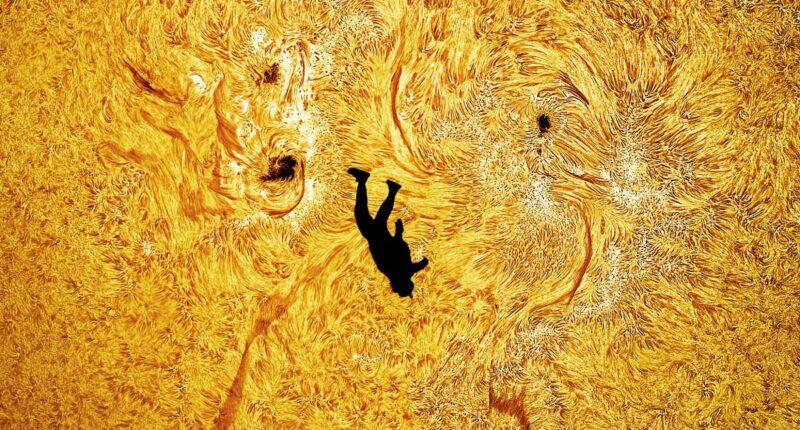Share this @internewscast.com
A captivating photograph has emerged, capturing the seemingly impossible moment of a skydiver descending as if from the sun itself. The image, described as “absolutely preposterous,” has caught the attention of many for its surreal appearance.
Dubbed “The Fall of Icarus,” this remarkable shot was crafted by Andrew McCarthy, an astrophotographer renowned for his expertise in solar imagery. His passion for photographing the sun culminated in this breathtaking scene.
McCarthy revealed that achieving this stunning effect required “immense planning and technical precision.” The goal was to create the illusion of the skydiver, Gabriel Brown, appearing to plummet through the cosmos. Brown, who is also a musician, executed his daring jump from a small paramotor, soaring from around 3,500 feet (approximately 1,070 meters) above the ground.
Positioning was key: McCarthy set up his camera nearly two miles (3.2 kilometers) away from the jump site. This strategic placement allowed him to focus both on the sun and Brown as he descended, capturing the fleeting moment when Brown passed directly in front of the camera lens.
The precision required for this shot meant McCarthy had only a split second to seize the perfect image, a testament to his skill and dedication to his craft.
That gave the photographer just a fraction of a second to capture the precise moment Mr Brown passed in front of his lens.
The spectacular results have gone viral on social media, with space and photography fans flocking to share their praise.
Even SpaceX CEO Elon Musk took to X to congratulate Mr McCarthy, writing: ‘Nice shot’.

A photographer has captured an ‘absolutely preposterous’ snap of a skydiver appearing to fall from the sun.

Even SpaceX CEO Elon Musk took to social media to praise the incredible image, writing simply: ‘Nice shot’
Despite weeks of planning and precise calculations to work out the best possible position, capturing this unlikely shot still took extreme patience.
The small, light aircraft proved to be far less predictable than hoped, and getting it in just the right spot proved extremely challenging for pilot Jim Hamberlin.
Mr McCarthy told Daily Mail: ‘Getting the alignment right was a huge challenge and lesson in patience.
‘There were many passes with the aircraft that were so close but not good enough, and they ended up circling for an hour until they were aligned correctly with my narrow field of view.
‘I absolutely love the contrast of the small human against our huge, dynamic star. It’s the juxtaposition that makes this so special, and feels so optimistic. Like despite our small size, we’re capable of so much.’
Incredibly, after several attempts to get the alignment right, Mr McCarthy and Mr Brown were able to capture the shot on the very first jump of the day.
Mr Brown wrote on X: ‘I can’t BELIEVE we pulled it off.
‘It took months of planning and a stupid amount of math, but I couldn’t be happier with the result! Best skydive of my life!’

The photo was captured by astrophotographer Andrew McCarthy, who says that the shot took incredible levels of planning

Mr McCarthy says that this image is likely the ‘first photo of its kind in existence’

The skydiver in the photograph, musician Gabriel Brown (right), jumped from a small propeller–powered paramotor from an altitude of around 3,500 feet (1,070 metres). To have Mr Brown and the sun in shot, Mr McCarthy (left) had to take the photo from almost two miles (3.2 km) away
After being shared on social media, The Fall of Icarus soon went viral as impressed fans gushed over the stunning image.
Even NASA astronaut Don Petit, widely regarded as one of the world’s best photographers, praised Mr McCarthy’s work, writing on X: ‘Wow!’.
Meanwhile, another commenter chimed in: ‘My mind is gonna explode trying to figure out how the hell you plan these shots.’
‘WOW!!!! That is wildly brilliant,’ one enthusiastic fan added.
Another wrote: ‘Incredible. Pure excellence.’
Although the sun is roughly 93 million miles (150 million kilometres) from Earth, Mr McCarthy’s photo still reveals an amazing level of detail.
Behind the silhouetted skydiver in The Fall of Icarus, you can see the dark, cooler patches of sunspots and the thin stripes of filaments created by the sun’s swirling magnetic fields.
This is possible because the photo was taken in a part of the visible light spectrum where small details aren’t drowned out by the sun’s bright outer layers.

On social media, space fans rushed to share their praise, with one commenter describing the stunning solar image as ‘pure excellence’

NASA astronaut Don Pettit, regarded as one of the world’s best space photographers, complimented Mr McCarthy’s work

Another commenter wrote that their mind was ‘gonna explode’ thinking about the logistics behind this photograph
In particular, Mr McCarthy shoots in the Hydrogen–alpha band, which is a wavelength of light produced by the sun’s cooler regions.
This blocks enough light to look at the sun through a telescope without being blinded, but not so much light that the details are totally lost.
Mr McCarthy has used this same technique to capture other stunning ‘transit photos’ of objects passing in front of the sun.
Earlier this year, he captured a ‘once–in–a–lifetime’ shot of the ISS passing in front of the sun at the exact moment a solar flare erupted into life.
He has also photographed a SpaceX rocket passing in front of the sun during launch, as well as ultra–high definition images of the lunar surface.








